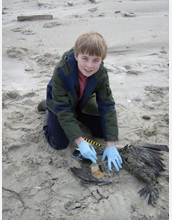Multimedia Gallery
COASST Project (Image 3)
A young Coastal Observation and Seabird Survey (COASST) volunteer processes a cormorant on the coast of Oregon. COASST is a citizen science program based at the University of Washington under the direction of Julia K. Parrish, a professor and associate director at the School of Aquatic & Fishery Sciences. More than 600 "COASSTers" collect monthly data on seabird mortality at more than 300 beaches in the North Pacific, from California to Alaska. COASST believes citizens of coastal communities are essential scientific partners in monitoring marine ecosystem health. By collaborating with citizens, natural resource management agencies and environmental organizations, COASST works to translate long-term monitoring into effective marine conservation solutions.
COASST is supported by a grant from the National Science Foundation (grant DRL 11-14734). To learn more about NSF's support of citizen science projects see the NSF Discovery story Novel Answer to That Perennial "Earth Day" Question: "What Can I Do to Help?" To learn more about COASST, visit the project's website Here. (Date of Image: Unknown) [Image 3 of 6 related images. See Image 4.]
Credit: Courtesy COASST
Images and other media in the National Science Foundation Multimedia Gallery are available for use in print and electronic material by NSF employees, members of the media, university staff, teachers and the general public. All media in the gallery are intended for personal, educational and nonprofit/non-commercial use only.
Images credited to the National Science Foundation, a federal agency, are in the public domain. The images were created by employees of the United States Government as part of their official duties or prepared by contractors as "works for hire" for NSF. You may freely use NSF-credited images and, at your discretion, credit NSF with a "Courtesy: National Science Foundation" notation.
Additional information about general usage can be found in Conditions.
Also Available:
Download the high-resolution JPG version of the image. (3.3 MB)
Use your mouse to right-click (Mac users may need to Ctrl-click) the link above and choose the option that will save the file or target to your computer.

